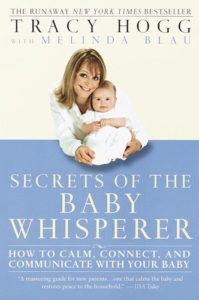In 1999, I flew cross country to meet the late Tracy Hogg, the original and incomparable “Baby Whisperer.” I was amazed. Here was a real-life Mary Poppins with a Yorkshire burr to match. Having worked with more than five thousand babies over the past twenty years, and dubbed “The Baby Whisperer” by a grateful Hollywood mom, Tracy was warm, funny, and able to understand every coo and cry. After months of following her around, watching her interact with babies and their parents, I captured her smarts and her common sense on paper. Over the next six years, we produced three best-selling–and still very popular–books about caring for babies and toddlers.

Secrets of the Baby Whisperer
Our first book became an instant New York Times bestseller when it was published in 2001.
It has since been translated into twenty-three languages. Filled with simple, accessible strategies that you can use as early as the first weeks of your baby’s life, we lead with a questionnaire that sheds light on your baby’s personality. Is he or she an Angel, Textbook, Touchy, Spirited, or Grumpy type? We then introduce simple acronyms to help you keep the principles of baby whispering in mind. For example, “SLOW” (Stop, Listen, Observe, and figure out What’s up) reminds you that you need to take a breath to better understand what your infant is “saying”–whether she is hungry, tired, in real distress, or just in need of a cuddle. “EASY” (Eat, Activity, Sleep, and time for You) enables you to keep on track. Establishing a predicable routine is vital to your baby’s health and so is taking care of yourself. One chapter is devoted to each of the letters in EASY, so you’ll learn how to feed and provide safe activities for your baby, how to foster “sensible sleep” (nap and bedtime practices that don’t rely on cry-it-out methods), and how to take care of yourself. You’ll also find out how to avoid “accidental parenting”– practices that later backfire – and what to do when you have to break those bad habits.
Secrets of the Baby Whisperer for Toddlers

Our second “secrets” book is an exploration of the energetic and often unnerving toddler years.
It offers the same winning blend of Tracy’s knowledge and uncanny intuition as our first. Starting with the simple but essential premise that there is no such thing as a “typical” child, we revisit the baby “types” as toddlers. We then guide you through a new set of acronyms: H.E.L.P. (Hold back, Explain, Limit, Praise) reminds you of the four elements that foster growth and independence and, at the same time, keep your toddler safe. With T.L.C. ( Talk, Listen, Clarify), you’re better able to figure out what your little one is thinking. R & R ( Routines and Rituals) gives structure and predictability to your little one’s daily life and a sense of continuity to his or her early year. Because toddlerhood is all about firsts and new social situations, we also teach you how to help your child manage his emotions and to “rehearse for change”–take on small challenges before expecting them to conquer big unknowns. The advice is practical, reassuring, and written with wit, making this book a great companion during the magical, challenging toddler years.

The Baby Whisperer Solves All Your Problems
This book is a compilation of readers’ questions after our first two books were published.
It is a veritable encyclopedia of baby whispering, covering a range of eating, sleeping, and behavioral issues. We go beyond general principles, tailoring the advice to specific groups: birth to six weeks, six weeks to four months, four to six months, six to nine months, nine months to a year, one to two years, and two to three years. In each case, you’ll be taught what to look for, what to ask, and when to worry.
The two chapters on eating will help you manage the transitions from breast or bottle to solids and finger foods to teaching your little one how to act at the dinner table. Three chapters on sleep help you troubleshoot nap and nighttime issues and explain how Tracy’s unique “pick up/put down” method can be used at different ages. You’ll also find chapters on potty training, understanding emotional development, applying the “The Twelve Principles of Problem Solving,” and using conscious “discipline” to compassionately correct bad habits. This is a book you can read cover-to-cover or use as a reference when you’re faced with a problem that takes you by surprise.